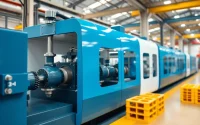Essential Guide to Nitrogen Regulators: Selection, Use, and Applications
Understanding Nitrogen Regulators
What is a Nitrogen Regulator?
A nitrogen regulator is a crucial mechanical device used to control the flow and pressure of nitrogen gas from a storage cylinder to various applications. Its primary function is to reduce the high-pressure gas from the cylinder down to a usable, lower pressure, ensuring that the nitrogen is delivered at the appropriate rate for its intended purpose. Nitrogen regulators are essential in numerous industries including refrigeration, HVAC systems, food and beverage dispensing, and laboratories.
Importance in Various Industries
The role of nitrogen regulators transcends mere gas control; they are pivotal in maintaining operational efficiencies and safety across a range of environments. For instance, in the HVAC industry, nitrogen is often used to pressure-test systems and purge lines, ensuring that installations are free from leaks and performing optimally. Similarly, in the food and beverage sector, nitrogen is utilized to dispense soft drinks and beers, where maintaining a consistent pressure is key to delivering high-quality beverages.
Furthermore, laboratories rely on nitrogen regulators for processes that require an inert atmosphere, preventing reactions that might compromise sensitive experiments. With such a broad spectrum of applications, selecting an appropriate nitrogen regulator is essential for operational efficiency and safety.
Basic Components and Functionality
A typical nitrogen regulator is composed of several key components including a pressure gauge, adjusting knobs, inlet and outlet connections, and safety mechanisms. The nitrogen regulator operates by receiving high-pressure gas from a cylinder through its inlet. The internal mechanisms then reduce this pressure to a more manageable level, which can be further adjusted based on specific demands through the adjustment knobs. The pressure gauge provides real-time feedback, allowing operators to monitor the gas pressure accurately.
Additionally, many nitrogen regulators are designed with unique features such as filters to prevent contaminants from entering the system and various outlet options to accommodate different connection types, enhancing versatility.
Selecting the Right Nitrogen Regulator
Factors to Consider: Pressure and Flow Rate
Choosing the right nitrogen regulator depends on several critical factors, primarily operating pressure and flow rate. Understanding the delivery requirements of your application is essential. For example, if you’re using nitrogen for leak testing in HVAC applications, you’ll need a regulator that can handle high pressures, sometimes exceeding 300 psi.
Flow rate is equally important; regulators are tested for their performance under different flow conditions. Knowing the flow rate required for your specific application ensures that you select a regulator that can deliver nitrogen consistently without fluctuations, thereby improving the performance of your systems.
Choosing Between Single and Dual Outlet Options
When it comes to nitrogen regulators, options typically come down to single or dual outlet configurations. A single outlet regulator is sufficient for straightforward applications—where one nitrogen flow line is necessary. However, for more complex systems where multiple nitrogen supplies are needed at different pressures, a dual outlet regulator becomes indispensable. This feature allows users to operate two different devices simultaneously without the need for additional hardware.
Choosing between these options depends on your specific operational needs and future scalability considerations. An assessment of your current and future projects will aid in making a more informed decision regarding which configuration serves best.
Top Brands and Models Overview
Several leading brands offer high-quality nitrogen regulators, each with unique features and price points. Brands such as Victor, Smith, and Uniweld provide robust options adapted to various applications, including high-pressure scenarios and standard flow settings. For instance, Victor regulators are well-regarded for their durability and precise control mechanisms, making them ideal for high-demand environments. Smith regulators are known for their easy-to-read gauges and user-friendly adjustment features suited for beginners and professionals alike.
When selecting a brand, consider product reviews, warranty conditions, and service availability. Moreover, certifications such as ISO compliance can indicate the reliability and quality of the products, ensuring they meet industry standards for safety and efficacy.
Installation Tips for Your Nitrogen Regulator
Safety Precautions Before Installation
Installing a nitrogen regulator requires adherence to strict safety protocols. Before beginning the installation process, make sure to wear appropriate personal protective equipment (PPE) such as gloves and safety goggles. It’s essential to work in a well-ventilated area to mitigate any risks associated with nitrogen displacing oxygen.
Additionally, ensure the workspace is free from flammable materials, and familiarize yourself with the specific manufacturer guidelines regarding installation. If using a pressure cylinder, check for any signs of damage or wear—never commence the installation process with defective equipment.
Step-by-Step Installation Guide
Installing a nitrogen regulator can be straightforward if the following steps are observed:
- Ensure that the nitrogen cylinder valve is closed before beginning the installation.
- Attach the regulator to the cylinder by aligning the inlet on the regulator with the valve connection on the cylinder. Tighten the connection securely but avoid overtightening.
- Connect the outlet of the regulator to the intended application or system using appropriate tubing or piping.
- Open the valve slowly to allow gas to flow into the regulator. Monitor the pressure gauge for any irregularities.
- Adjust the outlet pressure to your specifications, ensuring that it remains stable.
After installation, conduct a leak test using a soapy water solution to identify any escaping gas. If bubbles form, re-tighten the connections to ensure a secure fit.
Common Mistakes to Avoid
Even with careful planning, installation errors can occur. Here are some common mistakes to avoid:
- Neglecting to check compatibility: Always ensure that the regulator is compatible with the nitrogen supply and application. Mismatches can lead to malfunction.
- Overtightening connections: While it’s necessary to secure fittings, excessive force can damage threads and compromise seals.
- Ignoring leaks: After installation, failing to check for leaks can pose serious safety risks, including suffocation in confined spaces.
How to Use a Nitrogen Regulator Effectively
Operating Procedures for Different Applications
Operating a nitrogen regulator requires an understanding of the specific application demands. For pressure-testing HVAC lines, start with the pressure set to the manufacturer’s recommended levels. Engage the nitrogen slowly to avoid shocking the system and allow it to stabilize before monitoring system integrity.
In beverage dispensing, regulate the pressure according to the beverage specifications; different drinks require varying pressure levels for optimal flow and carbonation. Always consult the product manuals or industry guidelines to achieve the best results.
Adjusting Pressure Settings Safely
Adjusting pressure settings on your nitrogen regulator must be done with caution. To do this effectively:
- Ensure that the regulator is not connected to a rigid system while making adjustments to avoid damage.
- Use the adjustment knob to set desired pressure before fully opening the nitrogen supply valve.
- Monitor the gauge closely as you make adjustments to avoid exceeding maximum pressure limits.
- Once the pressure is established, secure the adjustment knob to prevent inadvertent changes.
Maintenance Practices for Longevity
Regular maintenance is vital for the longevity and reliability of your nitrogen regulator. Consider these best practices:
- Inspect regularly: Check for wear and tear, particularly on seals and fittings, to prevent leaks.
- Clean components: Periodically clean regulators to remove any contaminants that might affect performance.
- Test gauges: Calibrate pressure gauges regularly to ensure accurate readings.
Following these maintenance practices can significantly extend the life of your nitrogen regulator and ensure consistent performance.
Common Issues and Troubleshooting
Identifying Problems with Your Nitrogen Regulator
Even with proper use and routine maintenance, issues can arise with nitrogen regulators. Common symptoms of malfunction include fluctuating pressure readings, leaks at connection points, and failure to adjust pressure settings. Identifying these problems early is crucial to avoid potential system failures.
How to Solve Pressure Fluctuations
Pressure fluctuations can be alarming and, if left unchecked, can compromise operations. If you experience such issues:
- Inspect the regulator for any visible signs of damage or malfunction.
- Check all connections for tightness and leak-free performance.
- Look for blockages in the flow path that may cause interruptions in gas delivery.
In many cases, simple maintenance or minor adjustments can resolve these issues.
When to Seek Professional Help
Some issues require professional intervention. If you experience persistent problems despite troubleshooting efforts, or if you suspect damage to critical components, it’s important to consult a qualified technician. Attempting to fix significant malfunctioning without expertise can exacerbate the issue and compromise safety.


